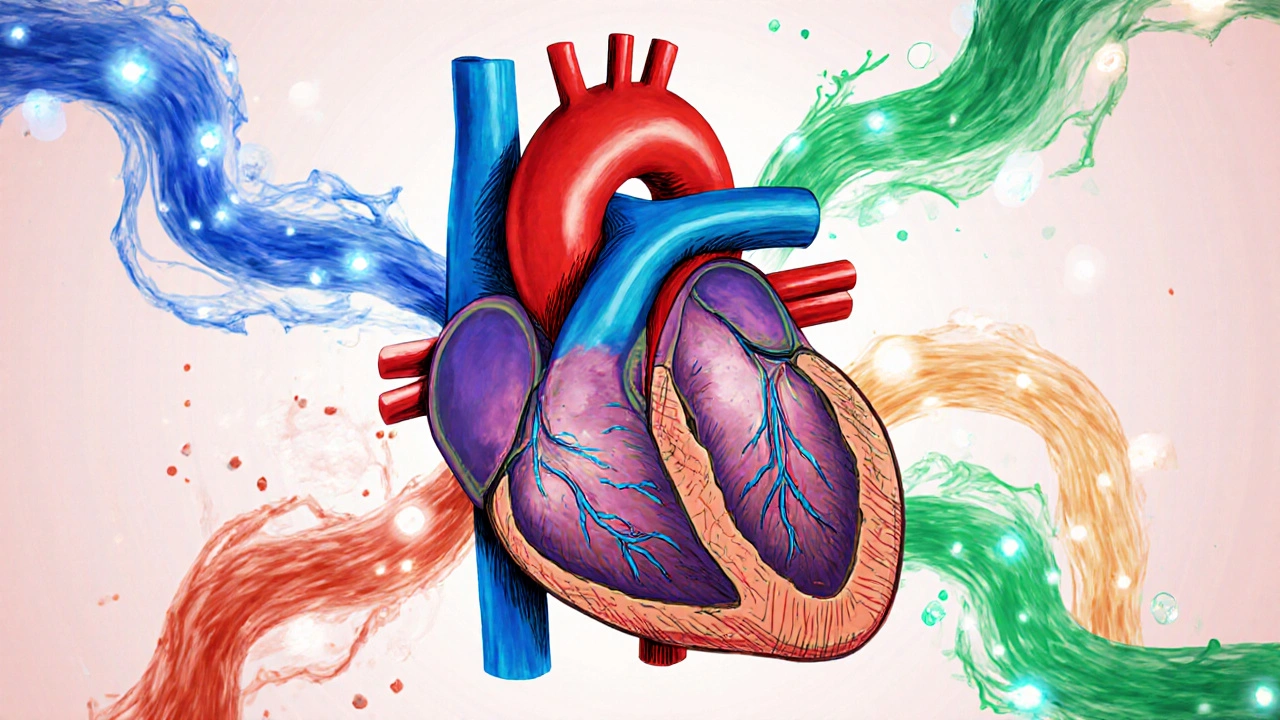Anti-Ischemic Drug Selector
Select Your Patient Profile
When treating chronic angina, Vastarel (Trimetazidine Dihydrochloride) is a metabolic anti‑ischemic agent that improves heart‑muscle energy use during low‑oxygen episodes. It’s not a blood‑pressure pill or a classic beta‑blocker - it works at the cellular level, helping cells make ATP more efficiently when oxygen is scarce. If you’re scanning the pharmacy aisle for “the best anti‑ischemic drug,” you’ll quickly notice that Vastarel isn’t the only option. Below we break down how it stacks up against the most common alternatives, so you can decide which one fits your condition and lifestyle.
TL;DR - Quick Takeaways
- Vastarel improves mitochondrial efficiency, making it useful for patients who can’t tolerate beta‑blockers.
- Ranolazine and ivabradine target heart‑rate and sodium channels, offering better symptom control for some angina types.
- Nicorandil blends nitrate‑like vasodilation with potassium‑channel opening - good for refractory cases.
- Traditional beta‑blockers and calcium‑channel blockers remain first‑line for most stable angina.
- Side‑effect profiles differ: Vastarel is generally well‑tolerated, while ranolazine may cause dizziness and nausea.
How Vastarel (Trimetazidine) Works
Trimetazidine belongs to the class of metabolic modulators. Instead of changing heart‑rate or blood‑pressure, it shifts the heart’s fuel preference from fatty acids to glucose. Glucose oxidation requires less oxygen per ATP molecule, so the heart can keep pumping even when the coronary arteries are narrowed.
Key attributes of Vastarel:
- Mechanism: Inhibits long‑chain 3‑ketoacyl‑CoA thiolase (LC‑3‑KAT), reducing fatty‑acid β‑oxidation.
- Typical dose: 35mg twice daily (extended‑release tablets).
- Onset: Symptom improvement often noticed within 2‑3 weeks.
- Regulatory status: Approved in Europe, Asia, and many Latin American countries; not FDA‑approved for chronic angina in the U.S.
Top Alternatives - What They Are and Who They Help
Below are the five most frequently prescribed anti‑ischemic drugs you’ll encounter alongside Vastarel.
- Ranolazine - a sodium‑channel blocker that improves myocardial relaxation and reduces oxygen demand.
- Ivabradine - selectively slows the sinus node, lowering heart‑rate without affecting contractility.
- Nicorandil - combines nitrate‑like vasodilation with ATP‑sensitive potassium‑channel opening.
- Beta‑blockers (e.g., metoprolol, atenolol) - reduce heart‑rate, contractility, and oxygen demand.
- Calcium‑channel blockers (e.g., amlodipine, diltiazem) - cause coronary artery dilation and lower myocardial workload.
Side‑Effect Snapshot - How the Drugs Differ
| Drug | Common Mild Side‑Effects | Serious Risks |
|---|---|---|
| Vastarel (Trimetazidine) | Gastro‑intestinal discomfort, dizziness | Rare movement disorders (parkinsonian‑like) at high doses |
| Ranolazine | d>Headache, constipation, nauseaQT‑interval prolongation, especially with CYP3A4 inhibitors | |
| Ivabradine | Bradycardia, luminous phenomena (phosphenes) | Severe bradyarrhythmias if combined with beta‑blockers |
| Nicorandil | Headache, flushing, mild dizziness | Rare ulcerative skin lesions (particularly in Asian populations) |
| Beta‑blockers | Fatigue, cold extremities | Exacerbated asthma, severe bradycardia |
| Calcium‑channel blockers | Swelling, headache, flushing | Hypotension, heart‑block in high‑dose verapamil |

When Vastarel Might Be a Better Choice
Consider Vastarel if you meet one of these scenarios:
- You have chronic stable angina but cannot tolerate beta‑blockers due to asthma or severe depression.
- You’re already on a calcium‑channel blocker, and your doctor wants an additional agent that doesn’t further lower blood pressure.
- You need a drug that works without affecting heart‑rate, which is crucial for patients with pacemakers.
- You’re looking for a relatively inexpensive option that’s covered by many European national health plans.
In contrast, if you primarily suffer from exertional angina triggered by high heart‑rate, ivabradine or a beta‑blocker might provide faster symptom relief.
Choosing an Alternative - Decision Guide
Use the chart below to match your clinical profile to the most suitable drug class.
| Patient Profile | Top Recommendation | Why It Fits |
|---|---|---|
| Intolerant to beta‑blockers (asthma, severe fatigue) | Vastarel | Works without affecting heart‑rate or bronchial tone |
| Requires heart‑rate reduction but normal BP | Ivabradine | Selective sinus‑node inhibition, no blood‑pressure drop |
| History of QT prolongation | Beta‑blocker + calcium‑channel blocker | Avoids additional QT‑impacting agents like ranolazine |
| Refractory angina despite standard therapy | Nicorandil | Dual vasodilatory action opens collateral flow |
| Kidney impairment (eGFR <30mL/min) | Ranolazine (dose‑adjusted) | Primarily hepatic clearance, dose can be lowered safely |
Practical Dosing & Monitoring Tips
Below is a cheat‑sheet you can print or bookmark.
- Vastarel: Start 35mg twice daily. Check for dizziness after the first week. No routine ECG required unless combined with QT‑prolonging drugs.
- Ranolazine: Begin 500mg twice daily; increase to 1000mg twice daily after one week if tolerated. Monitor QT interval at baseline and after dose escalation.
- Ivabradine: 5mg twice daily; can be uptitrated to 7.5mg twice daily. Measure resting heart‑rate; stop if <50bpm.
- Nicorandil: 10mg three times daily (extended‑release 20mg once daily). Watch for skin ulceration in the first month.
- Beta‑blocker (Metoprolol): 25‑100mg once daily; titrate to heart‑rate 60‑70bpm. Caution in diabetics - may mask hypoglycemia symptoms.
- Calcium‑channel blocker (Amlodipine): 5‑10mg once daily. Good for patients with hypertension plus angina.
Always discuss renal and hepatic function with your prescriber, especially for ranolazine and ivabradine.
Frequently Asked Questions
Is Vastarel safe for long‑term use?
Clinical studies up to five years show a stable safety profile. Most patients only experience mild GI upset. Rare movement‑disorder cases have been linked to high doses (> 140mg/day) and are reversible after stopping the drug.
Can I combine Vastarel with a beta‑blocker?
Yes, they act via different pathways. The combo is often used when angina persists despite optimal beta‑blocker dosing, but your doctor should monitor heart‑rate and blood pressure.
Why isn’t Vastarel approved by the FDA?
The FDA required additional cardiovascular outcome trials that haven’t been submitted. Europe, Asia, and several Latin American regulators approved it based on existing efficacy data.
What’s the main difference between Ranolazine and Vastarel?
Ranolazine blocks late sodium currents, reducing intracellular calcium overload. Vastarel shifts heart metabolism from fatty acids to glucose. The result: ranolazine mainly lowers oxygen demand, while Vastarel improves oxygen efficiency.
Do any of these drugs affect cholesterol?
None of the anti‑ischemic agents directly modify lipid levels. If you need cholesterol control, you’ll still require a statin or other lipid‑lowering therapy.
Bottom Line - Pick the Right Tool for Your Heart
There’s no one‑size‑fits‑all pill for angina. Vastarel shines when you need a metabolic boost without changing heart‑rate or blood‑pressure, especially if beta‑blockers are off the table. For patients whose main problem is a racing heart, ivabradine or a classic beta‑blocker will hit the mark faster. If you’ve tried the basics and still feel pain, adding nicorandil or ranolazine can open up new pathways.
Talk to your cardiologist, review your comorbidities, and use the comparison tables above as a cheat‑sheet. The right choice often comes down to side‑effect tolerance, existing meds, and how your body reacts to each mechanism.





September 28, 2025 AT 07:12 AM
Reading through the anti‑ischemic drug showdown feels like watching a circus where the clowns are pretending to be cardiologists 🤡. First, Vastarel’s claim of “metabolic modulation” sounds impressive until you realize it’s basically shuffling fuel sources without any real proof of mortality benefit. The author conveniently skips over the fact that the drug isn’t even FDA‑approved for chronic angina in the United States, which should raise red flags for anyone with a modicum of common sense. Meanwhile, the alternatives like ranolazine and ivabradine have robust trial data that actually demonstrate reductions in angina episodes and improved exercise tolerance. Let’s not forget that Vastarel’s side‑effect profile includes rare but serious movement disorders, a detail buried deep in the fine print. The table comparing side effects reads like a checklist for a pharmacy‑school exam, yet the narrative glosses over the clinical relevance of those numbers. If you’re a patient who can tolerate beta‑blockers, why would you gamble on a drug that merely shifts metabolism? The article’s tone seems biased toward promoting a drug that is cheaper in some European health plans, which feels like a subtle marketing ploy. In reality, the first‑line treatments remain beta‑blockers and calcium‑channel blockers for good reason – they have decades of evidence behind them. I’m also puzzled by the recommendation for patients with pacemakers; a drug that doesn’t affect heart rate is nice, but pacemaker patients often benefit more from rate‑controlling agents. The author’s “quick takeaways” list is helpful, but it’s overly simplistic and ignores patient‑specific nuances. Moreover, the interactive selector widget is a neat gimmick, yet it doesn’t replace a thorough discussion with a cardiologist. Bottom line: Vastarel may have a niche role, but it’s far from the universal solution the article seems to suggest 😊. Readers should approach this with a healthy dose of skepticism and consult their healthcare provider before swapping out proven therapies.
October 3, 2025 AT 08:55 AM
From a pharmaco‑dynamic perspective, the author’s exposition suffers from a paucity of mechanistic granularity. The discourse on LC‑3‑KAT inhibition is cursory, failing to juxtapose the allosteric modulation observed with trimetazidine against the state‑dependent sodium channel blockade of ranolazine. Consequently, the comparative efficacy narrative is overly reductive, bordering on didactic oversimplification. Moreover, the omission of pharmacokinetic parameters-particularly hepatic CYP450 isozyme affinity-obfuscates potential drug‑drug interaction pitfalls. An elite synthesis would integrate these variables into a cohesive decision matrix, rather than relegating them to a peripheral footnote.
October 8, 2025 AT 10:38 AM
When you think about the heart as a philosophical engine it asks you what it truly values – efficiency or sheer power and the drug choices mirror that dilemma. Vastarel whispers to the mitochondria offering gentle guidance while ranolazine shouts louder demanding immediate relief. The subtlety of metabolic modulation can be underrated but it aligns with the notion that true health is a balance not a battle.
October 13, 2025 AT 12:21 PM
Honestly this whole thing is a load of baloney and the author just throws jargon around like a drunk at a pub. Vastarel might work for some but it’s not a miracle cure and the side effect list is half a mile long lol. If you cant handle beta blockers you could try this but dont expect it to fix everything.
October 18, 2025 AT 14:04 PM
Ever wonder why Big Pharma never pushes Vastarel in the US? It’s because the shadowy committees in Washington have a secret agenda to keep us hooked on pricey patents while the cheap metabolic modulators are quietly shelved. The table of side effects is a smokescreen, the real risk is being kept in the dark about how these chemicals alter our brain chemistry. Stay vigilant, question the narrative, and remember that every “approved” drug comes with a hidden price tag beyond dollars.
October 23, 2025 AT 15:46 PM
Hey folks! If you’re feeling overwhelmed by the options, remember that you don’t have to choose everything at once. Start with the medication that feels safest for your current health status and add a new agent only if you still have symptoms. Small steps can lead to big improvements, and your doctor will help you fine‑tune the plan. Keep your head up – you’ve got this!
October 28, 2025 AT 16:29 PM
Vastarel is an option for those who can’t take beta‑blockers.
November 2, 2025 AT 18:12 PM
That concise point highlights a specific patient subgroup, which can help clinicians quickly identify when Vastarel might be appropriate without wading through the entire table.
November 7, 2025 AT 19:55 PM
The article does a decent job of laying out the basic facts, but it glosses over the nuanced decision‑making process that cardiologists actually face day‑to‑day. For instance, while Vastarel’s metabolic effects are touted as benign, the real-world adherence data suggests patients often discontinue due to subtle gastrointestinal discomfort that isn’t captured in the trial endpoints. Additionally, the piece fails to discuss the cost‑effectiveness analysis, which is crucial when prescribing in a healthcare system burdened by escalating drug prices. Another omission is the impact of polypharmacy in elderly patients; the potential for drug‑drug interactions, especially with CYP450 substrates, can’t be ignored. Finally, the comparison chart could benefit from a column indicating the strength of guideline recommendations, as this guides clinicians in aligning practice with evidence‑based standards. Overall, the article is a helpful primer but leaves out the gritty details necessary for informed prescribing.
November 12, 2025 AT 21:38 PM
The narrative captures the drama of choosing an anti‑ischemic agent, yet it feels like a theatrical performance where the understudy never gets a chance to shine. While Vastarel steps onto the stage with a modest applause, the seasoned veterans-beta‑blockers and calcium‑channel blockers-command the house lights with undeniable authority. In this saga, the patient is the silent audience, yearning for relief but often left in the shadows of clinical indecision.
November 17, 2025 AT 23:21 PM
Wow, what a groundbreaking revelation-another drug that does "something" and costs less than a latte. Guess we’ll all start chanting the Vastarel hymn now, because nothing says "medical advancement" like repackaging old metabolic tweaks with fancy brand names. 🙄
November 23, 2025 AT 01:04 AM
The comparative matrix is useful for triaging patients, especially when considering pharmacokinetic profiles and contraindication spectrums. Integrating evidence‑based algorithms with real‑world efficacy data can streamline the selection process for clinicians dealing with heterogeneous angina presentations.
November 28, 2025 AT 02:46 AM
It’s clear that this so‑called "alternative" is just a smokescreen to undermine our proven national standards. We should stick with the tried‑and‑true American guidelines rather than dabbling in foreign‑made metabolic gimmicks.
December 3, 2025 AT 04:29 AM
Dear colleagues, the presented data underscores the importance of individualized therapy based on hemodynamic parameters and comorbid conditions. When assessing a patient with contraindications to beta‑blockers, metabolic modulators such as the discussed agent may be considered, provided that the clinician evaluates renal function and potential drug‑interaction profiles in accordance with established protocols.
December 8, 2025 AT 06:12 AM
While the exposition attempts to be exhaustive, it inadvertently meanders into verbosity that obscures salient points. A more succinct articulation would better serve the readership, particularly regarding the comparative risk–benefit analysis of the therapeutic options under consideration.